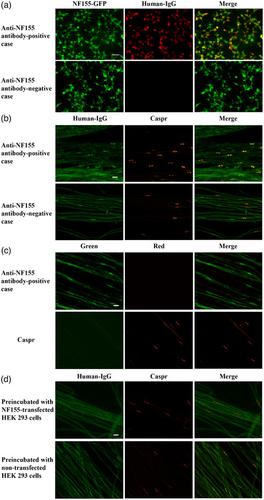当前位置:
X-MOL 学术
›
Clin. Exp. Immunol.
›
论文详情
Our official English website, www.x-mol.net, welcomes your
feedback! (Note: you will need to create a separate account there.)
The prevalence of anti-neurofascin-155 antibodies in patients with neuromyelitis optica spectrum disorders
Clinical & Experimental Immunology ( IF 3.4 ) Pub Date : 2021-05-17 , DOI: 10.1111/cei.13617 Sheng-Hui Chang 1 , Jing Wang 1 , Xu Zhang 2 , Ning Zhao 1 , Kun Jia 3 , Ming Yi 1 , Qiu-Xia Zhang 1 , Hui Zhai 1 , Xiao-Wen Li 1 , Chun-Sheng Yang 1 , Li Yang 1 , Lin-Jie Zhang 1
Clinical & Experimental Immunology ( IF 3.4 ) Pub Date : 2021-05-17 , DOI: 10.1111/cei.13617 Sheng-Hui Chang 1 , Jing Wang 1 , Xu Zhang 2 , Ning Zhao 1 , Kun Jia 3 , Ming Yi 1 , Qiu-Xia Zhang 1 , Hui Zhai 1 , Xiao-Wen Li 1 , Chun-Sheng Yang 1 , Li Yang 1 , Lin-Jie Zhang 1
Affiliation

|
Anti-neurofascin-155 (NF155) antibodies have been observed in two cases with neuromyelitis optica spectrum disorders (NMOSD). This study investigated the prevalence of anti-NF155 antibodies in patients with NMOSD and the clinical features of anti-NF155 antibody-positive patients. Sera from 129 patients with NMOSD were screened with anti-NF155 antibodies by cell-based assay (CBA) and re-examined using immunostaining of teased mouse sciatic nerve fibres. Fifty-six patients with multiple sclerosis (MS) and 50 healthy controls (HC) were also enrolled for detecting anti-NF155 antibodies. A total of 12.40% (16 of 129) of patients with NMOSD were positive for anti-NF155 antibodies confirmed by both CBA and immunostaining. Immunoglobulin (Ig) G1 was the predominant subclass. However, none of 56 MS patients or 50 HC were positive for anti-NF155 antibodies. Anti-NF155 antibody-positive NMOSD patients had a higher proportion of co-existing with autoimmune diseases (p < 0.001) and higher positive rates of serum non-organ-specific autoantibodies, including anti-SSA antibodies (p < 0.001), anti-SSB antibodies (p = 0.008), anti-Ro-52 antibodies (p < 0.001) and rheumatoid factor (p < 0.001). Five anti-NF155 antibody-positive NMOSD patients who took part in the nerve conduction study showed mildly abnormal results. Differences in some nerve conduction study parameters were observed between anti-NF155 antibody-positive and negative patients. Anti-NF155 antibodies occurred in a small proportion of NMOSD patients. Anti-NF155 antibody-positive NMOSD patients tended to co-exist with autoimmune diseases.
中文翻译:

视神经脊髓炎谱系障碍患者抗神经筋膜蛋白 155 抗体的流行情况
已在两例视神经脊髓炎谱系疾病 (NMOSD) 病例中观察到抗神经筋蛋白 155 (NF155) 抗体。本研究调查了 NMOSD 患者中抗 NF155 抗体的流行情况以及抗 NF155 抗体阳性患者的临床特征。来自 129 名 NMOSD 患者的血清通过基于细胞的测定法 (CBA) 用抗 NF155 抗体进行筛选,并使用经过梳理的小鼠坐骨神经纤维的免疫染色进行重新检查。还招募了 56 名多发性硬化症 (MS) 患者和 50 名健康对照 (HC) 以检测抗 NF155 抗体。经 CBA 和免疫染色证实,共有 12.40%(129 名中的 16 名)NMOSD 患者的抗 NF155 抗体呈阳性。免疫球蛋白 (Ig) G1 是主要的亚类。然而,56 名 MS 患者或 50 名 HC 均无抗 NF155 抗体阳性。p < 0.001) 和更高的血清非器官特异性自身抗体阳性率,包括抗 SSA 抗体 ( p < 0.001)、抗 SSB 抗体 ( p = 0.008)、抗 Ro-52 抗体 ( p < 0.001) 和类风湿因子 ( p < 0.001)。参与神经传导研究的 5 名抗 NF155 抗体阳性 NMOSD 患者显示轻度异常结果。在抗 NF155 抗体阳性和阴性患者之间观察到一些神经传导研究参数的差异。抗 NF155 抗体出现在一小部分 NMOSD 患者中。抗 NF155 抗体阳性的 NMOSD 患者倾向于与自身免疫性疾病共存。
更新日期:2021-05-17
中文翻译:

视神经脊髓炎谱系障碍患者抗神经筋膜蛋白 155 抗体的流行情况
已在两例视神经脊髓炎谱系疾病 (NMOSD) 病例中观察到抗神经筋蛋白 155 (NF155) 抗体。本研究调查了 NMOSD 患者中抗 NF155 抗体的流行情况以及抗 NF155 抗体阳性患者的临床特征。来自 129 名 NMOSD 患者的血清通过基于细胞的测定法 (CBA) 用抗 NF155 抗体进行筛选,并使用经过梳理的小鼠坐骨神经纤维的免疫染色进行重新检查。还招募了 56 名多发性硬化症 (MS) 患者和 50 名健康对照 (HC) 以检测抗 NF155 抗体。经 CBA 和免疫染色证实,共有 12.40%(129 名中的 16 名)NMOSD 患者的抗 NF155 抗体呈阳性。免疫球蛋白 (Ig) G1 是主要的亚类。然而,56 名 MS 患者或 50 名 HC 均无抗 NF155 抗体阳性。p < 0.001) 和更高的血清非器官特异性自身抗体阳性率,包括抗 SSA 抗体 ( p < 0.001)、抗 SSB 抗体 ( p = 0.008)、抗 Ro-52 抗体 ( p < 0.001) 和类风湿因子 ( p < 0.001)。参与神经传导研究的 5 名抗 NF155 抗体阳性 NMOSD 患者显示轻度异常结果。在抗 NF155 抗体阳性和阴性患者之间观察到一些神经传导研究参数的差异。抗 NF155 抗体出现在一小部分 NMOSD 患者中。抗 NF155 抗体阳性的 NMOSD 患者倾向于与自身免疫性疾病共存。









































 京公网安备 11010802027423号
京公网安备 11010802027423号